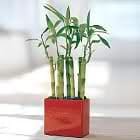There’s more than just luck or feng shui when you own a lucky bamboo. A popular gift for almost any occasion, Lucky bamboo is selling like hotcakes in the market. It is basically grown in water in a decorative glass container with colored stones or pebbles to keep the plant upright, no soil.
 Selling Lucky bamboo is a very lucrative business, the cheapest is priced at P120 and the most expensive could reach up to more than a P1000. Lucky bamboo could grow for years indoors and virtually no care is needed. These plants are also used as accent plants in dish gardens or as fillers in bouquets. Lucky bamboo is really a Dracaena, not a bamboo. Specifically, Dracaena sanderiana has two cultivars– Gold and Ivory which came from Congo, Africa.
Selling Lucky bamboo is a very lucrative business, the cheapest is priced at P120 and the most expensive could reach up to more than a P1000. Lucky bamboo could grow for years indoors and virtually no care is needed. These plants are also used as accent plants in dish gardens or as fillers in bouquets. Lucky bamboo is really a Dracaena, not a bamboo. Specifically, Dracaena sanderiana has two cultivars– Gold and Ivory which came from Congo, Africa.
Gold and Ivory plants are slender, succulent with unbranched stems. Gold or ‘Yellow Corn’ has dark green leaves with occasional faint lines of pale green. Ivory, also called ‘striped corn plant’ or ‘white corn’ has alternate glossy green leaves that taper to a point. It has broad white to yellow-green margins.
For ornamental growers who wish to expand their income and sell the Lucky bamboo as a hydroponic plant or as a foliage plant, there is a technology that has been packaged by the Institute of Plant Breeding of the University of the Philippines, Los Baños (IPB-UPLB). The mass production technology consists of three techniques: the ‘exposed’ method, the use of plastic tent, and the mist system.
Gathering and Preparation of Planting Materials
1. Tip Cuttings
* Secure healthy tip cuttings 10-15 cm long from vigorous plants.
* Place the cuttings in 6x6x11 polyethylene plastic bags then sprinkle with water to prevent from drying.
2. Nodal Cuttings
* Cut the plant 5 cm from the base. An erect plant can attain a height of 70 cm.
* Secure about five to eight cuttings with three nodes each. Retain at least two to three leaves per cutting to ensure faster growth of the plant.Place in a polyethylene plastic bag and sprinkle with water.
3. Hormone Application
* To hasten rooting, soak the cuttings in 100 ppm Indole Butyric Acid (IBA) solution for 30 minutes prior to planting. Cuttings soaked in IBA solution will have uniform roots a week earlier than untreated cuttings.
Mass Propagation
For the mass production of D. sanderiana, three techniques can be employed: the ‘exposed’ method, the use of plastic tent and the mist system.
1. Exposed Method
* Prepare rooting medium composed of 1:1 burnt rice hull and sawdust. Place the medium in a 6x6x11 polyethylene plastic bag.
* Water the medium thoroughly.
* Plant the cuttings about 5 cm deep in the medium. A maximum of five cuttings can be planted in 6x6x11 polyethylene plastic bag. For tip cuttings, remove the 3-4 lowermost leaves before inserting the base of the stems.
* Place the plants in an area with 60-70% shade.
* Water the plants daily.
2. Plastic Tent
The use of plastic tent is ideal for large-scale production. The structure, which measures 4 x 1 m bed can accommodate 60-80 plants depending on the size of the pots. It is fully enclosed with a plastic sheet and placed in a partially shaded area or inside a screenhouse. The roof is slightly inclined to ensure that no water will clog on top. The cuttings planted in polyethylene plastic bags are placed inside the plastic tent and are watered at least once a day, usually in the mornings to prevent drying.
3. Mist System
The same procedure in the exposed method is followed in planting the cuttings for mist application. In this method, the plants are placed in a mist bed where they are subjected to continuous misting during the day from 7 am to 4 pm. The bags or pots used have at least four holes at the bottom to prevent water lodging that may result to stem rot.
Transplanting
Rooted cuttings are ready for transplanting when roots are already established, usually 3-4 weeks for tip cuttings and 4-5 weeks for nodal cuttings.
* Transplant individually in a 6x6x11 polyethylene plastic bag containing an equal mixture of burnt rice hull and sawdust.
* Keep the plants under partially shaded areas (60-70% shade) for a week before gradually transferring outside. Do not expose the plants to full sunlight during the dry season to prevent leaf burn.
* Avoid crowding the plants to minimize competition for space which might result to plants producing longer leaves. Shorter and more compact leaves are preferred in the market.
* One week after transplanting, apply complete fertilizer (14-14-14) at the rate of 1 tbsp/4 L of water thrice a month and once a month with urea (46-0-0), 1 tbsp/4 L of water. If slow release fertilizer (17-17-17) will be used, apply only once in every three months.
* Water the plants regularly during the dry season and minimally during the rainy season.
* Handweed as often as needed.
(For more information, please contact: Dr. Joy Eusebio of the Crops Research Division, PCARRD Los Baños , Laguna at tel no. 049 536-0014 to 536-0020.)
Article from Junelyn S. de la Rosa- bar.gov.ph, October-December 2001 Volume 3 No. 4
Photo: giftbee.com